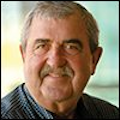Locating underground utilities is becoming more and more difficult for all utility companies due to increased congestion on main feeder runs and in subdivisions. In the old days of locating our concerns were dozers, backhoes, trenchers, and shovels. In today’s environment there is the dreaded horizontal boring machine. The boring machine can be controlled to an exact depth, but the problem lies with today’s cable locators in giving the exact depth of existing utilities.
Cable locators do not find pipes and cables. They find electromagnetic fields that surround the pipes or cables. Why does it matter? Because electromagnetic fields do things that pipes and cables don’t do. Buried conductors don’t move but the electromagnetic fields that are applied to them do.
Electromagnetic fields are subject to distortion by the method of signal application, grounding, congestion, and the frequency applied. The first indication of a distorted electromagnetic field around any buried conductor is a difference in field location using the NULL, PEAK, and DIFFERENTIAL functions on the locator receiver. Any difference when changing receiver functions is an indication to the operator that the locate is wrong.
Any current-carrying conductor, such as a telephone cable, already has electromagnetic fields around it. One example is the harmonics of ground return current from distributed power. Most quality brands of cable locators have the ability of the receiver to select 60 Hz and passively locate buried conductors. There is no way of knowing which utility is being located without tracing the located conductor back to its source. A quality passive locate occurs only when there are no other current-carrying conductors in the vicinity.
Activate locating by applying an individual signal at an individual frequency with the transmitter and selecting that frequency with the receiver. Most quality locator transmitters have at least 1 low frequency setting (below 1kHz) and several high frequency settings from around 8kHz to 300kHz. When selecting a frequency with the transmitter:
RULE: USE LOW FREQUENCY FOR ACCURACY, AND USE HIGH FREQUENCY FOR CONVENIENCE.
Transmitter Hookup
There are 3 methods of applying an AC signal at frequency to a metallic conductor: 1.) Direct Connection, 2.) Inductive Coupling, and 3.) Induction.
The Direct Connection is a must for low frequency applications.
Setup is very important. When connecting the transmitter cord to ground an independent ground is a must. Place the ground at a 90-degree angle from the suspected cable path opposite other utilities. Connect the black lead of the transmitter cord to the ground and connect the red clip to the isolated shield. Do not use a common ground such as a distribution power ground. If the far end ground is common, signal can come back from other common grounded conductors and can skew the locate.
As an example, a locating technician removes the shield from ground and uses the ground at the next pedestal for a return. A portion of the signal returns to the ground rod. The rest of the signal continues down the shield to the distribution power neutral ground and reflects back on other cables or conductors and skews the locate.
The direct connection can also be used for high-frequency application. The red clip can be attached to an isolated shield or a cable pair within the sheath. Sometimes connecting to open vacant cable pairs give better results than working pairs.
Induction
Inductive Coupling is for high-frequency application only.
The coupler can be placed around an individual cable or conductor. One example would be to place the coupler around a buried drop at the network interface and locating the drop from the network interface to the pedestal.
Induction should be used only when there are no other current-carrying conductors in the area, and for manhole conduit locating.
To use the induction mode set the transmitter on the ground over the suspected cable path. When the transmitter is set to the induction mode a closed loop transmitter will radiate the signal into the earth, creating an electromagnetic field around the buried conductor at that frequency.
Keep in mind that if you opt to use high frequency with a direct connection, the inductive coupler, or by induction, that signal will readily spill onto other buried conductors, resulting in a miss locate. The higher the frequency used the more likely the signal will couple to other buried utilities.
An example of this is placing the inductive coupler around a buried drop at the network interface, attempting to locate that drop to the buried pedestal, and the signal spills over on to the buried CATV cable and causes a miss locate to the CATV pedestal.
Locating buried utilities is a difficult task, so keep in mind when locating to use low frequency for accuracy and high frequency for convenience. If you are not sure of the locate, back up and shift to low frequency.
Signing off
Any thoughts on this or other topics that are important to you — please, please contact me. I aim to please, and if I am not the expert to address your copper infrastructure issues and questions, I will find that expert! Contact me via email [email protected] or call or text 831.818.3930.
"I’m thrilled with the new ISE rebranding and committed to be here as ISE’s OSP Expert for the long-term." — Don
About the Author

